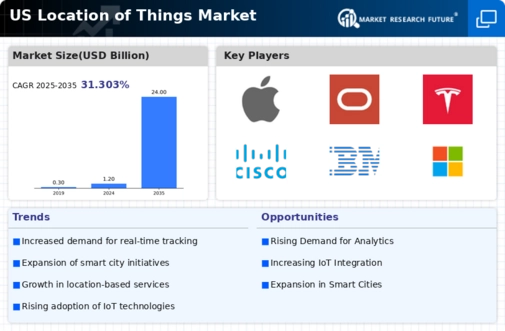The US Location of Things Market has witnessed significant growth driven by advancements in technologies such as IoT, GPS, and mobile communications, which have enabled the precise tracking and positioning of assets, people, and devices. This market is characterized by a diverse array of players, each vying for leadership through innovation, strategic partnerships, and robust product offerings. Competitive insights reveal that businesses are increasingly focusing on enhancing their location-based services and solutions to cater to the growing demand for real-time data analytics, efficient logistics, smart city applications, and personalized user experiences.
The interplay between established technology giants and emerging startups fosters a dynamic ecosystem, where companies are continuously evolving their strategies to maintain a competitive edge, creating opportunities for collaboration and competition alike.Apple holds a formidable presence in the US Location of Things Market, leveraging its advanced technology ecosystem comprising hardware, software, and services. The company's strengths lie in its innovative approach to location-based services, providing users with seamless integration across devices through offerings like Apple Maps and location tracking features in various applications.
Apple’s vast user base, driven by the popularity of its products, allows the company to gather rich location data, which enhances the accuracy and functionality of its services. Moreover, Apple's commitment to privacy and security resonates well with consumers, allowing it to differentiate its offerings and build user trust.
The company's continuous investment in research and development, coupled with a strong brand reputation, further solidifies its competitive positioning in the US market.Oracle, on the other hand, has carved out a unique niche within the US Location of Things Market by providing comprehensive solutions that leverage location intelligence to drive business decisions.
The company offers a suite of products and services that cater to various industries, including cloud-based analytics, database solutions, and enterprise resource planning systems that incorporate location data for more informed strategies. With a strong market presence supported by strategic partnerships and collaboration with technology leaders, Oracle enhances its service offerings. The company's strengths lie in its ability to integrate location services seamlessly into existing business operations, providing clients with actionable insights and improving operational efficiency.
Oracle's strategic mergers and acquisitions have also bolstered its capabilities in the location-based market, enabling the company to expand its technological resources and enhance its competitive advantage within the US region.

























Leave a Comment